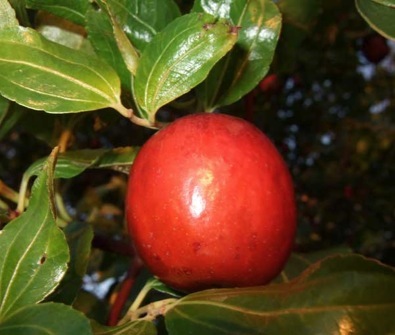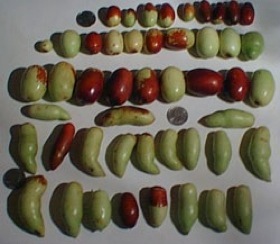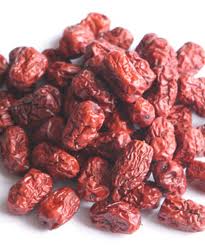Ziziphus zizyphys: The Misspelled Jujube
If you don’t find the Jujube tree, it will find you. The Jujube is covered with long, sharp thorns. They hunt you down. They daw blood. They hurt. If I get within a yard of a Jujube Tree I somehow get skewered. Badly. Continuously. Inevitably.
Another little fact you are never told about the tree is if you plant it then move it the old roots, and the new roots where you plant it, will send up young shoots annually seemingly forever. You end up with a multitude of shin-high saplings puncturing your ankles. The Jujube is a pain but its fruit is tasty and versatile.
In the Buckthorn Family, the Jujube is distributed in warm-temperate and subtropical regions around the word. In the US it is naturalized in southern states from Georgia to California, excepting Louisiana and New Mexico but including Utah. Throughout the genus the leaves are quite regular and distinct. They alternate, are finely toothed, and have three prominent basal veins (coming from where the leaf meets the stem.) They also usually have two spines at the base of the leaf. The small flowers are chartreuse (yellow-green) with five petals. The fruit is a drupe, edible, that can range from green when unripe to yellow to brown to red or black. When green it tastes like and apple and has the texture of an apple. When ripe it is closer to a date in flavor and texture. A single stone contains two black seeds which are not eaten.
The Jujube has been cultivated for over 4,000 years and there are some 400 cultivars, that is, specifically bred varieties. Native to China — it’s been called the Chinese date and Indian date — Jujubes got to southern Europe around the time of the Romans and to the United States in 1837. Starting in 1908 high-quality cultivars were also introduced, initially in Tifton, Georgia by the USDA.
The genus has an interesting naming history. It was originally Rhammus zizyphys. But 15 years later it was put into a new genus but misspelled as Ziziphus. Naming rules prohibit calling the genus and the species by the same name. But since one was misspelled the name uniquely stands as Ziziphus zizyphus. There are many species including Ziziphus jujuba, where the common name comes from. It is said ZIZ-ih-fuss jew-JEW-buh (or SIZE-eh-fus.)
Ziziphus comes from two different words. Zizafun was the Persian word for the Z. lotus tree (Jujube.) Phus is latinized Greek meaning “bearing.” So Ziziphus in English means Jujube bearing. Jujube can be said two ways: JEW-jewb or JUJU-bee.
While Jujubes can be eaten out of hand they’re made into a wine, are cooked, and often are de-stoned and dried. A leaf extract, Ziziphin, alters taste perceptions of sugar in humans. It makes sweet things taste not sweet. Think of it as the anti-sweet. See recipes below. There are also numerous medicinal uses as well.
Green Deane’s “Itemized” Plant Profile
IDENTIFICATION: A small, deciduous tree to 40 feet usually with single trunk and rounded crown. Waxy leaves are simple and alternate, green on top, whitish green on bottom, in two rows on zigzaging twigs. They have hairy stems, very fine teeth, and three prominent veins. The brown bark has vertical fissures. And while I say the tree has thorns they are rightly spiny stipules. Bottom line: At each leaf you will find a half inch to one inch long very sharp thorn. Beware!
TIME OF YEAR: Fruits late in to winter depending upon climate. The fruit do not all ripen at the same time.
ENVIRONMENT: Likes sunny locations and sandy soil. Like regular watering but is drought tolerant, hardy down to -25F but needs around 200 chill hours to fruit if planted in a warm climate. It does not like to grow in a container.
METHOD OF PREPARATION: Fruits are eaten raw, candied, made into drinks, and dried. They can eaten unripe, ripe and can be left to dry on the tree. The ripe fruit is very high in vitamin C.
Jujube Cake
1 cup sugar
1/2 cup butter
2 cups dried, minced jujube
1 cup water
Bring these to a boil then set aside to cool
2 cups wheat flour
1 teaspoon soda
1/2 teaspoon salt
Sift these together then add to the above mixture. Bake at 325° F
Candied Jujubes
Wash about three pounds dried jujubes; drain and prick each several times with a fork. In a kettle bring to a boil 5 cups water, 5-1/2 cups sugar, and 1 tablespoon corn starch. Add the jujubes and simmer, uncovered, stirring occasionally, for 30 minutes. Cool, cover, and chill overnight. The next day bring syrup and jujubes to a boil and simmer, uncovered, 30 minutes. With a slotted spoon lift jujubes from syrup and place slightly apart on rimmed pans. Dry in oven, or in sun for about 2 to 3 days. Check fruit frequently and turn fruit occasionally until the jujubes are like dry dates.
Jujube Syrup
Boil syrup remaining from the Candied Jujubes, uncovered, until reduced to about 2 cups. Use over pancakes and waffles. Store in the refrigerator. Other uses: Substitute the dried jujube wherever recipes call for raisins or dates.





Hi, out of interest is Ziziphus ziziphus and Ziziphus mauritiana the same plant in question? It seems to be by description and looks, but here in Australia it is referenced as Z.mauritiana..…
Two different species, both edible.
Interesting, thanks.
I just found fresh jujube fruit at a market where I shop so I had to pick some up just to see what it was like.
Sounds like some of the best recipes involve dried jujubes – can you tell me the best way to dry them?
I have a beautiful 10 year old jujube that we love. I just planted a moranga tree last year that looks just like are jujube, it even has the thorns and is sending out the same flowers as the jujube. Is it in the same family or is it the same plant? Can you eat the leaves of the jujube like the moranga tree ? Thanks Michael
No. There is a mix up somewhere. Moringas do not have thorns.
I am aware that this is a very late reply, so you’ve probably figured it out by now. Anyway, jujube trees will occasionally send up a new plant somewhere through the root system. I got mine because a neighbor down the street had an old jujube and it sent a root aaaalll the way into my yard and presto, one came up a few feet from the fence. Perhaps it was a coincidence? It may have just happened to sprout a new tree from the roots where you thought you had planted a moranga.
Either that or it got mixed up at the nursery. Perhaps a simpler explanation.
Spotting jujubes at my local market for a mere $1.49/pound, I rolled the dice.
Simply underwhelming.
Distantly apple-like, the first bite’s impression was too bland and faint to be called “taste.” I’ll leave the rest to ripen, wrinkle, and dry and try again later, but frankly wish I’d saved the buck and a half.
I can’t get near the plant without loss of blood.
Does anybody know which animal can climb up the jujube tree and eat all the fruit on the branches. We woke up today to find out all the fruits completely vanished, as if somebody intentionally picked them off the tree. We have several rabbits and few mice that I spot in the back yard, and a lot of birds of course.
Thanks…
I have seen in my 2 trees squirrels, opossums and raccoons. In fact last summer we lost almost all of our fruit to these animals. Mostly squirrels.
Hey I’ve heard some jujube species have a ‘high’ they give kind of like magic mushrooms. Does anyone know of that?
They just taste like apples to me.
Does anyone know if you can start aJujube tree from one of the fruit seeds. Also I just bought some at farmers market because it looked like a fruit my husband ate as a child at his grandfather’s place it was smaller in size but same taste however they called it a Japanese Date are they one and the same?
Yes you can… there is some debate how true it will be with such shoots often not fruiting.
I have two pretty jujube trees, one with grape-sized fruit and the other smaller. The smaller ones are a tad more flavoursome but i would describe both as BLAND. I have around fifteen species of birds that come to my garden, though I wonder how many of them feed on the jujubes. The thorny, shrubby tree offers perches for small birds like the white-eye. tailor bird and sparrow.
Smallfruir are Sherrwood, large are Li, taste about the same
just wondering for how long you need to bake the cake??? I don’t see a time on the recipe…
thanks.
My tree is producing beautifully! I was wondering, though, if anyone knows if the seeds are poisonous? I want to feed these to my rabbits and removing the pits is a pain (but we do it). My tree doesn’t really have thorns (I got it at ECHO in Ft. Myers, FL), though it does have what seem like could have been thorns (narrow bumps?) The fruit is more like an Asian pear, imo, than an apple.
When they were green I ate seeds and all.
I ate the seeds when the fruit were green. Never really got ripe fruit to try.
I grew up with “date” trees in East Texas. The trees looked the same but the shiny leaves were smaller. But…I don’t remember thorns. Is there a thornless, or less thorn prominent, variety?
is jujube lotus the same as common jujube? Thanks.
Jujube lotus is Ziziphus lotus and is another species related to Z. jujuba.